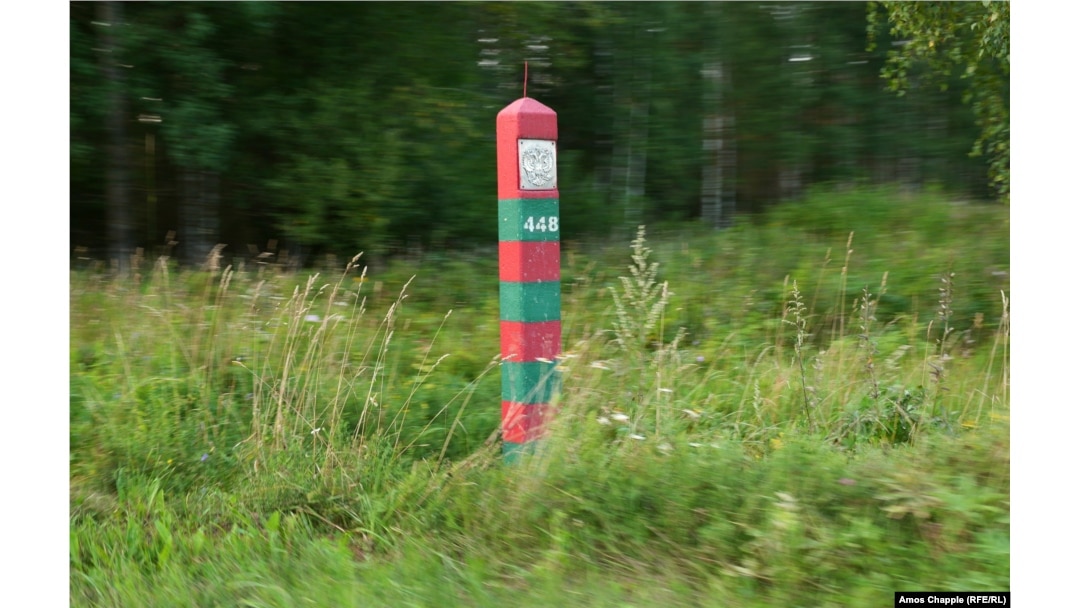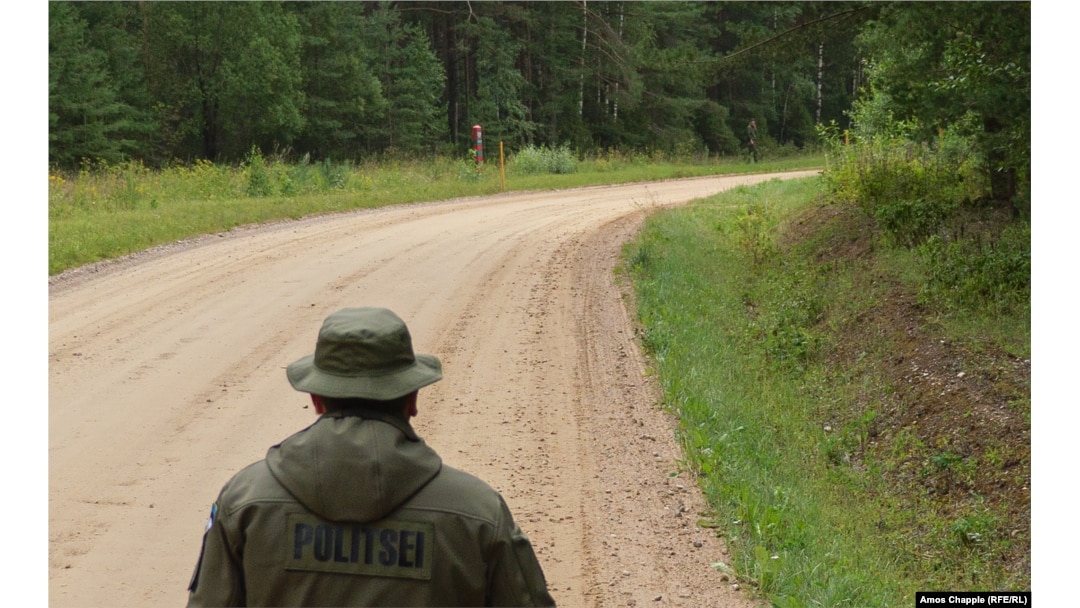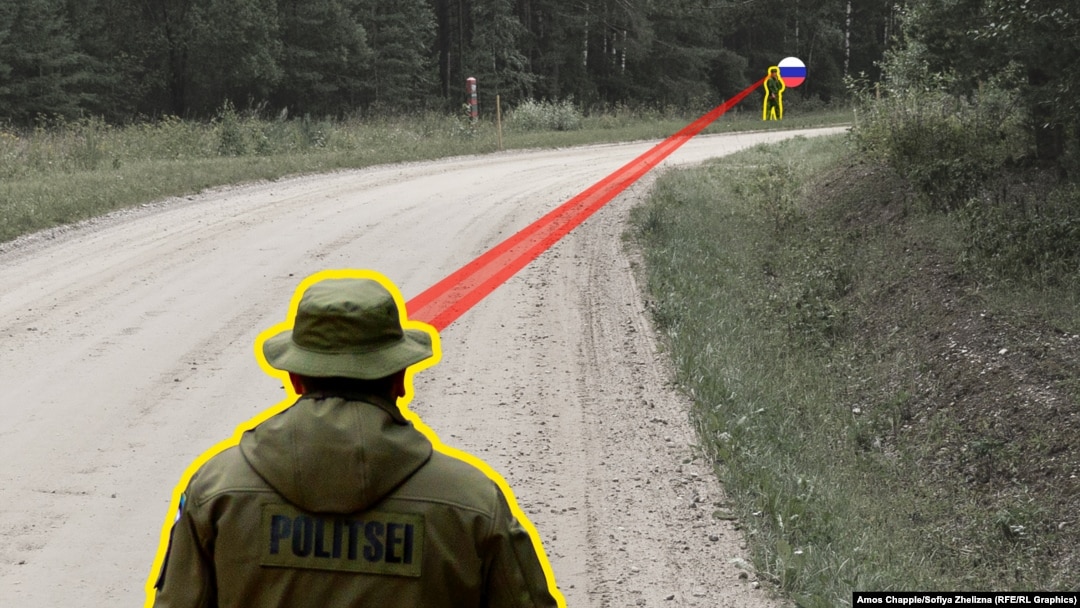I’m standing next to a Russian territorial marker, studying its gleaming, two-headed eagle, when Viktor Kullasaar, the Estonian border guard who escorted me here, says with firm urgency: "OK, no more pictures, we need to leave." One-hundred meters away a Russian border policeman has emerged from the forest next to our car and is looking straight at us.

A Russian border marker inside Saatse Boot as seen from a passing car.
We're in Saatse Boot, a wedge of Russian land that pokes into Estonia’s Setomaa parish and cuts through a road between two Estonian villages. The border anomaly has its origins in the Soviet Union’s annexation of Estonia during World War II.

A Russian border guard (top right) looks towards his Estonian counterpart inside the Saatse Boot.
After Stalin recaptured the tiny Baltic nation from the Nazis in 1944, the border between the Russian and Estonian Soviet republics was redrawn, shrinking Estonian territory. At the time, one ethnic Russian reportedly opted to keep his (now abandoned) farm inside Russian land, while the villages on either side remained in Estonian territory. The Russian farmer’s decision was of little consequence at the time, when there was free travel between the two Soviet states. But in 1991, Estonia regained independence and found itself with a little over one-square kilometer of Russian territory cutting across the only direct road between two villages.
A map of Saatse Boot (named for its bootlike shape) cutting across around 1 kilometer of Estonian road and, to the north, another tiny corner of Russian land that runs across the same road.
The Kremlin soon agreed to allow people on the Estonian side to use the road through Russian territory, but only under strict conditions: Those transiting must remain inside their vehicles and are not allowed to stop. “Vehicles” includes bicycles, cars, and motorbikes, but not scooters. Russia also reserves the right to stop any vehicle passing through the heavily monitored forest.
This has led to a trickle of international incidents, when people ignorant or dismissive of the rules were arrested by Russian border agents inside the zone. In 2017, two maintenance workers pulled over in the apparently empty forest to check their map. Russian border agents seized the two young men and took them to the nearest Russian border post. After paying a 2,000 ruble ($31) fine, the Estonians were released.
One man described what capture inside the boot used to be like. In 1997, Ivvo Palomiis attempted to walk through the territory late one night: “…suddenly a voice shouted in Russian, ‘Stop, otherwise I'll shoot!’ I was approached by four border guards with guns drawn who asked, ‘Who are you? Where are you going? Submit your documents.’” Palomiis was held for nearly 24 hours before being released back into Estonia.
A Russian border post (left) behind an Estonian border marker that says “STOP” in Estonian, English, and Russian. Estonian police warn people to stay more than 15 meters away from these Russian border markers.
Raul Kudre, the mayor of the Setomaa region, who was himself once seized by Russian border guards some 10 years ago while out jogging, told RFE/RL that things are more relaxed on the border today and “[locals] are used to it, they have adapted to the circumstances.”
But an increasing concern is the growing numbers of tourists who come for the thrill of driving through the boot and often break the rules that both Estonian and Russian border police enforce. A situation which Kudre says has ended “a bit sadly” for some tourists. In 2018, Estonian police fined a German man 60 euros ($67) for stopping his car inside Russian territory.
A digitally stitched panorama photo showing the fenced island of Russian territory just a few meters wide.
Two kilometers north of the boot, another tiny parcel of Russian land cuts through the same road. The second chunk -- the size of a hotel swimming pool -- is erroneously marked on Google maps but is hard to miss on the ground.
An Estonian border guard points out the incorrectly marked Russian border (gray line at right) on Google maps. In reality the Russian territory extends across the Estonian road.
A thicket of road signs indicates the upcoming blink-or-miss trip through Russia. According to one local whom RFE/RL spoke to, Russian border guards sometimes take a position inside the tiny wedge of land, watching Estonian cars pass by just a few meters away.
A road sign warning drivers of a 30-meter section of road that passes through Russian territory.
Russia and Estonia recently made moves towards resolving the border issue with a proposed land swap that would see Russia cede the two wedges of territory in return for an identically sized chunk of Estonian land elsewhere along the border. In 2013, the exchange was due to be finalized, but a last-minute disagreement shelved the treaty. Estonia’s border police told RFE/RL the planned land exchange is still "pending."
Estonian border guard Viktor Kullasaar monitors traffic through the meters-long stretch of Russian territory.
Back inside the boot, as I walk with Estonian border guard Kullasaar towards our car, the Russian border guard turns and melts back into the forest, apparently satisfied that I’m accompanied by the uniformed Estonian. As Kullasaar starts the car, I ask him what the opposing border guards say when they meet in the boot's uneasy no-man’s land -- at NATO's eastern edge with Russia. "Nothing," says Kullasaar. "We just salute and keep going. They’re doing their job, we’re doing ours."


